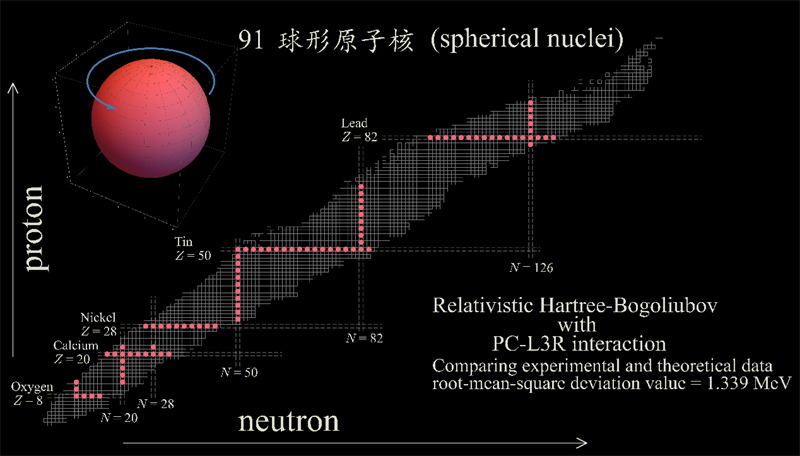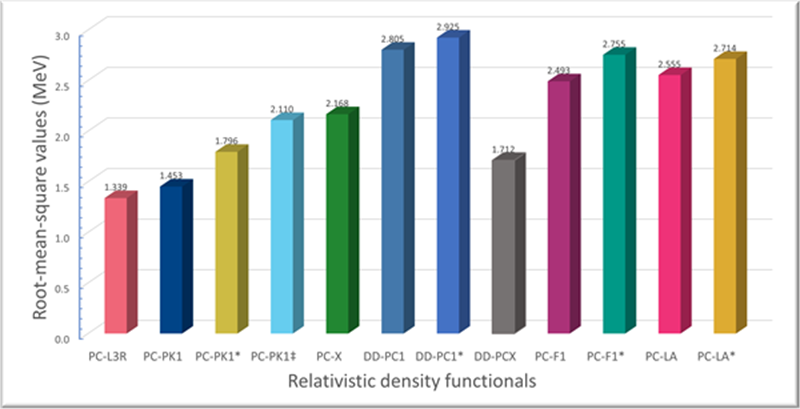Home / News / Latest News
06 06, 2023
Scientists Propose an Optimized Point-Coupling Interaction for Covariant Density Functional Theory
New experiments based on the recent advancements in radioactive ion beams and detectors reveal a wealth of structural phenomena in exotic nuclei. Having theoretical nuclear models capable of describing the properties of these exotic nuclei far from the region of stability is crucial for us to understand the interactions and configurations of nucleons in the exotic nuclei, to guide future experiments, and to predict the radioactive decays of exotic nuclei.
In a new study published in Physics Letters B, researchers from the Institute of Modern Physics (IMP) of Chinese Academy of Sciences (CAS) and the Technische Universität München proposed an optimized point-coupling interaction for the relativistic Hartree-Bogoliubov framework to quantify the nuclear bulk properties. The outcome serves as a stepping stone for the nuclear physics community to further investigate and to predict the important nuclear properties of exotic nuclei.
The covariant density functional theory is one of the most successful models for the study of nuclear structure. The relativistic Hartree-Bogoliubov framework belongs to the covariant density functional theory.
“We are beneficial from using the covariant density functional theory, for instance, the advantage of the natural inclusion of the nucleon spin degree of freedom. Meanwhile, the consistent treatment of isoscalar Lorentz-scalar and -vector self-energies, provides a unique parametrization of time-odd components of the nuclear mean field. A natural explanation of the empirical pseudospin symmetry is also permitted. Moreover, we can also get a distinction between scalar and four-vector nucleon self-energies for a new saturation mechanism of nuclear matter,” explained LIU Zixin, the first author of the paper and a Ph.D. student at IMP.
The researchers had taken more observables into account for optimizing the point-coupling interaction, i.e., the binding energies of 91 spherical nuclei, charge radii of 63 nuclei, and 12 sets of mean pairing gaps consisting of 54 nuclei in total.
Meanwhile, in order to better reproduce the experimental odd-even oscillations of the binding energies of nuclei, the researchers further optimized the separable proton and neutron pairing strengths together with the point-coupling interaction. “The results of the fit for the pairing strength show that the effective pairing-constant for the protons is smaller than that for the neutrons. This could be connected with the fact that the repulsive contribution of the Coulomb force to the pairing correlations reduces the size of the effective attractive pairing strength for protons,” said Peter Ring, the professor emeritus of Technische Universität München participating in this research project.
The results indicate that the newly optimized point-coupling interaction, with the acronym PC-L3R, is able to predict the best description on the experimentally determined binding energies of 91 spherical nuclei among all point-coupling interactions. Moreover, the calculated charge radii of 63 nuclei satisfactorily agree with the respective experimental findings.
“The PC-L3R point-coupling interaction provides a reliable alternative set of references for future studies based on the covariant density functional theory. We expect that the PC-L3R interaction is capable of describing the properties of exotic nuclei and of guiding future experiments. These properties include the binding energies, radioactive decays, and radii, of which can be measured in future advanced experiments,” said LAM Yi Hua, a researcher from IMP.
This work was financially supported by the Strategic Priority Research Program of CAS (No. XDB34020100), National Natural Science Foundation of China (No. 11775277), CAS President’s International Fellowship Initiative (No. 2019FYM0002), and the Deutsche Forschungsgemeinschaft (DFG, German Research Foundation) under Germany Excellence Strategy EXC-2094-390783311.

Figure 1. The 91 spherical nuclei (red dots) are plotted against the nuclear chart consisting of all experimentally discovered nuclei (background squares). (Image by LU Ning and LAM Yi Hua)

Figure 2. The root-mean-square deviation values of comparing the experimental and theoretical binding energies of 91 spherical nuclei. Among the commonly used point-coupling interactions, the PC-L3R interaction yields the set of theoretical binding energies closest to the experimental data. (Image by LAM Yi Hua)
Appendix(s):
Contact Information
Institute of Modern Physics
Email: lamyihua(a)impcas.ac.cn



 甘公网安备 62010202000713号
甘公网安备 62010202000713号


